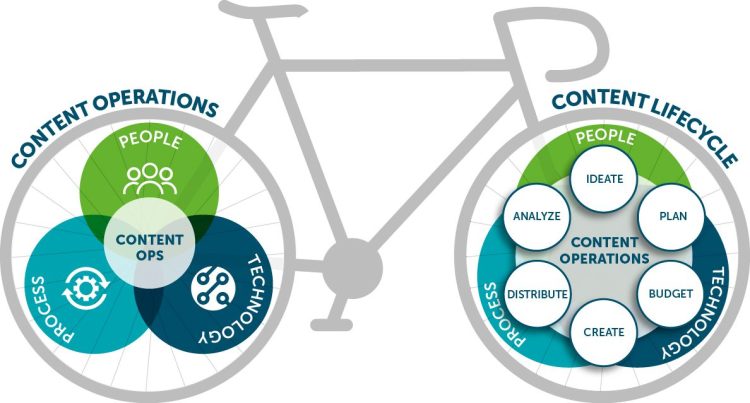Customers demand personalized experiences at every interaction. But organizations today struggle because of poor content operations. Here’s how an end-to-end content operations platform can help you win the race and bring your brand forward.
Digital content operations and triathlons have a lot in common. When you dive into defining content operations and all that it entails, there are some remarkable similarities between what it takes for success in a swim-bike-run race and what you need to do to build a genius brand.
Here’s how these two seemingly unrelated topics align:
- You have to be committed to putting in the time and effort to win: Whether creating an exceptional, personalized experience or ranking first in your age group, you?ve got to practice how you play to get there.
- You?ve got to leverage technology: Successful content operations use digital asset management (DAM) systems, analytics, project management tools, and other technologies for managing content. Triathletes rely on fitness wearables for metrics like Max VO2 and sensors in bicycle hubs to measure power output.
- A holistic approach ensures top performance: Having a strong content operations platform addresses every stage of content creation, from planning through performance analysis. Triathlons are about total body fitness, from nutrition through endurance.
- It’s a multi-disciplinary activity: You have to have clean data, personalization tactics, and a sound omnichannel strategy to achieve solid content operations. Naturally, triathletes need to have strong competencies in swimming, biking, racing?and mental fortitude to stay committed and push through fatigue.
- You have to have the agility to be ready for anything: Your content operations platform have to be nimble enough to respond to market conditions as they change or are disrupted (as we?ve seen this past year). And you have to be ready for anything on race day?choppy water, bad weather, a flat tire, anything.
I?m having fun riffing on my two favorite topics, but I?ve also seen the downside of not taking either one of these endeavors seriously. I?ve seen some of my competitors bent over on the side of the road, losing their lunch because they took shortcuts and weren’t properly trained for the distance, terrain, or conditions. And I?ve seen companies try to skip deploying a content operations platform and find themselves simply unable to deliver the personalized content experiences that customers everywhere have come to expect, which can seriously hurt their brand.
Content operations allows a brand to unite its operating model on a common set of capabilities across departments, agencies, and channels.
To avoid these pitfalls and get you into great shape for your race to achieving stellar content operations, let’s do a deeper dive, starting with defining content operations within your organization.
What is digital content operations?
Marketing teams produce tons of content, yet content operations isn’t always clearly understood or acknowledged for its vital strategic role.
Content operations is essentially a set of processes, people, and technologies needed to strategically plan, create, manage, and analyze all content types for all channels across an enterprise. At its core, it is a framework for how an enterprise creates rich and relevant content that powers exceptional customer experiences (CX).

That’s a high-level description of ?digital content ops.? Still, one aspect of that definition that’s often glossed over is the perspective of content operations as a strategic function for the entire business. In fact, content operations impacts every business unit, because content output speaks volumes about a company’s identity, its culture. Marketing, sales, the C-suite, human resources, R&D’they’re all directly affected by the branded content that gets in front of customers and the resulting experiences those customers have.
Any part of the business that creates, consumes, or shares content is part of the content ops ecosystem, which is nearly all of the business. And the best part of nailing exceptional content operations is that it allows a brand to unite its operating model on a common set of capabilities across departments, agencies, and channels.
Successful digital content operations creates a framework that unleashes the power of content and enables it to reach its full potential so that your enterprise can seamlessly deliver personalized customer experiences that deliver bottom-line results the C-suite is aiming for. Plus, like a shot of adrenaline, content ops also speeds up content creation, management, and delivery by breaking down silos between teams that can really gum up every content process.
Why you need a content operations platform
It’s not an exaggeration to say that content ops help enterprises do everything better. With a proven and solid framework for content development and execution, any organization can achieve excellence through all stages of the content lifecycle?planning, creation, reviews, distribution, and reuse.
If you’re not 100% sure that your business needs to integrate content operations as a vital strategic function, ask yourself these five questions:
- Does your content take too long to be developed?
- Is your content more focused on appearances than actual business value?
- Are you having difficulties prioritizing content work?
- Is finding the right content to reuse for campaigns a challenge?
- Are you flying blind without accurate data that tell you whether your content is working well and actually helping you achieve your objectives?
Any of those sound familiar? If your answers to some or all of these questions shine a light on current challenges in your organization, then a strong content operations platform might just be the jolt that takes you the last mile to victory.
What digital content operations can do for you
Now that you have a better understanding of content ops and how it can solve some common pain points and typical obstacles, let’s focus on exactly what outcomes you can expect when your team commits to embracing and deploying this essential framework.
At the heart of a great content operations platform is the aim to improve the customer experience?and for good reason. Fully 86% of buyers are willing to pay more for a great customer experience. What’s more, customers rarely stay loyal to a brand based on price or even product. The experience a customer gets from a brand is by and large what determines consistent purchases.
If an experience simply works, if customers aren’t forced to deal with brand inconsistency, then they’ll stick around and convert more often. And even if they don’t swipe their credit card right away, delivering a solid brand experience means you’ll have started to build a valuable relationship that you can cultivate.
But to do that, you need a content operations platform that enables on-brand experiences across every channel, every time.
When you truly integrate a digital content operations platform as a strategic function for the business, your team will be able to:
- Quickly seize opportunities in planning
- Create better content, more effectively
- Optimize workloads
- Centrally manage content use with easy findability
- Remain true to your brand guidelines, including tone and voice
- Ensure regulatory compliance
- View data insights on marketing’s contribution to the bottom line
Digital content operations and personalization
These days, it’s common knowledge that enterprises need to focus more on the customer experience, and personalization takes the spotlight. More than ever, consumers want to feel connected to a brand. And, when a customer feels that connection, they are much more likely to remain loyal. It’s that personalization that makes consumers feel like these brands really know them in a very personal way.
According to McKinsey, companies that have led the way in personalized marketing have driven 5 -15% increases in revenue, and 80% of consumers want personalization from retailers. Most of the personalization tactics that brands deployed focused predominantly on product recommendation content and triggered communications?fairly simple personalization that goes a long way.
Think about some of the top brands that have made personalization a pillar of their success. Brands like Spotify, Netflix, and Amazon have taken personalization to dizzying heights, ingraining consumers? expectations for individualized recommendations and content.
So, how can content operations empower and scale personalization for your enterprise?
An integrated content operations platform as part of a strategic function can help you ensure that your content strikes exactly the right chord for your customers. You’ll be able to consistently plan, develop and time the ideal content that resonates with your customers based on their unique data profile. Having these sort of personalization insights can help boost the performance of marketing campaigns and other customer engagements.
How digital content operations platforms drive personalization success:
- Sync up customer usage and profile data with content design and production efficiencies to ensure content gets to customers where they are?instead of forcing customers to come to you.
- The result: Robust, relevant content experiences that connect with your customers on a highly contextual level.
- Organize customer personalization data and centralize content storage to more easily imagine, design, and deploy experiences your customers actually like.
- The result: Personalized content focused on an individual’s interests or preferences will yield substantial advantages?increased customer trust, loyalty, and share of wallet.
- Make edits to projects, discuss direction changes, and stay on top of deadlines from a single location, so everyone across the team (even across departments) is on task and on point.
- The result: Empowers a holistic and collaborative approach, so marketing teams don’t work in silos, instead working together seamlessly to personalize content that gets results.
- Store different sizes and approved versions of a piece of content in one place to make delivering great experiences in every channel that much easier.
- The result: Where, when, and how you engage with content is vital to success; content ops helps ensure a seamless omnichannel experience, so customers get personalized content the way they want it.
Digital content operations’the race that never ends
I made some fun analogies between content ops and triathlon training and racing, but another similarity between the two that’s pretty important is understanding that they are both never-ending journeys. Like competing in triathlons, content operations is an evolving effort where you’re always aiming to do better and better. And as marketing continues to be expected to bring in revenue, perpetual advancement and evolution are only becoming more important. The old tricks just don’t work like they used to.
I?m always looking for that competitive edge, whether it be a new piece of fitness technology, nutrition enhancements, or a proven training regimen. As you begin your content operations journey, it’s critical to understand that the right technology and resources can help you continuously improve performance and sharpen your competitive edge over the competition.
TL;DR
- Content operations is defined as processes, people, and technologies needed to strategically plan, create, manage, and analyze all content types for all channels enterprise-wide.
- Content operations should be integrated as a strategic function for the business as a whole and not just as a sub-function of marketing.
- It’s vital to address the entire content lifecycle?planning, creation, reviews, distribution, reuse?and make it repeatable in any content operations platform.
- Truly integrating content operations bestows all kinds of benefits including increased efficiency, greater collaboration, regulatory compliance, and brand alignment.
- Personalization is paramount, and content ops can help you develop and deliver rich content that resonates with your customers?and gets them to convert.
Consider This
- What kind of experiences do your customers ask for?
- 2020 was a make or break moment for companies all over the world. Did your brand speed up or slow down?
- Less brand loyalty means more customers can be won. Is your company agile enough to get to where potential customers are?physically, digitally, and experientially?
Any of those sound familiar? If your answers to some or all of these questions shine a light on current challenges in your organization, then a strong content operations platform might just be the jolt that takes you the last mile to victory.



